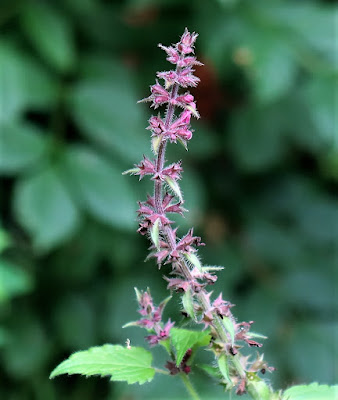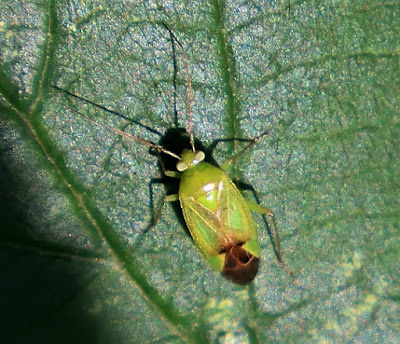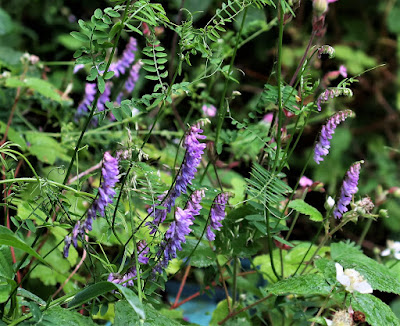The cold wet summer has resulted in overmuch green growth and M3 is dark and shady. I let in a little more light around Lammas (1st August) by pruning some of the more vigorous shoots on the cordons (hornbeam, ash, birch and oak). However, many of the usual plants have flowered including greater bird's-foot-trefoil, knapweed and hedge woundwort. The latter I noticed looks as though it has a spike of flowers but this is an illusion caused by coloured bracts, buds or faded blooms with only two or three flowers out at any one time.
Since September 2003 the author has been making a minimum intervention study of a square metre of land and the immediate surrounding area in his garden in the East Sussex Weald at Sedlescombe near Hastings, UK. By April 2016 over 1000 species of plants and animals (none of which has been deliberately introduced) had been recorded and the area featured on many TV and radio shows including Spring Watch, and The One Show.
Saturday, September 04, 2021
Diary July and August 2021
Tuesday, June 15, 2021
Diary June 2021
The month started very warm and sunny and the western end of Brambly Hedge started to burgeon. The area is roughly a 1 metre cube and is another good example of a very small nature reserve looking rather like a green igloo with various leaves and flowers poking out of the tope. Brambles provide the basic structure and support and some of the other plants that flourish in the sheltered area are tufted vetch, narrow-leaved vetch, goosegrass, black bryony and red campion.
Sunday, May 16, 2021
The Potato Square.
As I remarked earlier I have marked out for study a square metre in the bare earth of the potato patch tended last year by Tana. It is about 10 metres south of the original Square Metre and is already starting to green over I will run it as a sort of subsidiary to the Green Sanctuary/Square Metre proper and add updates in this section of the blog.
Things only started to happen towards the end of May 2021. Dandelions, creeping buttercup, herb robert and red campions started to flower, fallow deer came and grazed buttercup, sow thistle and red campion plants. I found a somewhat less than lively caterpillar which turned out to be a fragment of carpet. Bonfire moss is fruiting abundantly on patches of bare earth.
Plant list
American willow-herb (Epilobium ciliatum)
Annual meadow grass (Poa annua)
Bonfire moss (Funaria hygrometrica)
Bramble (Rubus fruticosus agg.)
Creeping buttercup (Ranunculus
repens)
Creeping comfrey (Symphytum
grandiflorum)
Dandelion (Taraxacum agg.)
Druce's crane's-bill
(G. x oxonianum)
Goosegrass or
cleavers (Galium aparine)
Herb bennett (Geum urbanum)
Herb-robert (Geranium robertianum)
? Hoary willowherb (Epilobium parviflorum)
Marsh thistle (Cirsium
palustre)
Nipplewort (Lapsana communis)
Potato (Solanum
tuberosum)
Ragwort (Senecio
jacobaea)
Red campion (Silene
dioica)
Rough meadow grass (Poa trivialis)
Rough sow-thistle (Sonchus
asper)
Stinging nettle (Urtica
dioica)
Sycamore (Acer
pseudo-platanus) Many seedlings
White clover (Trifolium repens)
Wood dock (Rumex sanguineus)
Yorkshire fog grass (Holcus lanatus)
Rhingia rostrata (Diptera: Syrphidae)
Cantharis ? cryptica/pallida
Comma (Polygonia c-album)
A shrew
Marmalade fly (Episyrphus balteatus)
Red admiral (Vanessa atalanta)
Meadow brown (Maniola jurtina)
Saturday, May 01, 2021
Diary, May 2021
A bright May Day morning to start the month off, but it was still quite cold with an overnight temperature just proud of 2 degrees C. Later there was some rain and for the first time in several weeks the leaves in The Green Sanctuary were sparkling with raindrops. There were four dandelion flowers and a few new primocanes of blackberry are growing visibly in Brambly Hedge alongside a good showing of tufted vetch.
Last year there was a cluster of American willowherb (Epilobium ciliatum) at the southern end of Cynthia's Ridge. The basal rosettes survived the winter but one plant has turned quite bright red and I fear it is mortally infected. However, its near neighbours on the left of the picture below seem unaffected.
On 4th May a red admiral butterfly was enjoying that part of the garden near the Square Metre, resting with wings open on any warm surface such as bare earth and logs. However it is still too cold for most butterflies although, on 5th, I saw one holly blue. It continued cold through 6th May with a northerly wind. Things continue to grow though and, in the Brambly Hedge West the tufted vetch plants have reached one metre tall. I noted that the first true leaves of sycamore seedlings vary through green to a variety of bronze shades.
On 7th May the red admiral was still in residence. One of the cleptoparasitic nomad bees, probably Nomada ruficornis, (see below) was prowling about as they often do at this time of year, looking for Andrena mining bee hosts. A bee fly, Bombylius major, was also hovering about looking for Andrena bees' nests.
On 8th May the rain started and was very welcome after April's drought, but it continued on and off for the rest of the month with the dry and the wet making conditions difficult for nesting birds and early flying insects.. I found a female Adela reamurella on a birch leaf and the birch itself has great curtains of male catkins that give the \Green Sanctuary and interesting top dressing when they fall.
By 9th May there was much new, fresh, bright foliage - the stones along Cynthia's Ridge have almost disappeared - and the birds were singing lustily, but there were few insects for them to eat. The fluffy seeds of nearby sallow bushes kept floating through the air and I found a tiny spider on a bramble leaf which my old friend Andy Phillips identified from a photo as Zilla diodia.
I have bought a pair of long-handled shears which are useful for trimming brambles as well as for cutting grass (especially in awkward corners). The weather is still cold for May and the only insect I saw over seral days was a nomad bee (Nomada sp.).
The first red campion in the Square Metre came out on 10th May. A few days later, with the weather still mixed and cold, various hoverflies started to appear including what I think is Rhingia rostrata, a rather scarce species that often appears in The Green Sanctuary in spring.
As the month wore on the rain continued to fall and the oak came out much later than the ash indicating, according to ancient custom, that we were in for a soak. The new oak leaves also sported two different kinds of gall: round, cherry-like ones (Cynips quercusfolii) and green bumpy ones that distorted the new leaves (Andricus curvator). On 19th May a few wrinkled ants (Myrmica ruginodis) appeared on leaves some way from the ground.
After this we had several periods of high rainfall and strong winds. There were great pools of water in local woodlands and the ground was littered with young leaves and twigs. I heard on one occasion that it was the wettest spring on record. On 25th, however, a small white butterfly was flying around the Green Sanctuary area and I spotted a colony of greenfly on one of the new rose shoots (it had gone by the following day, predated no doubt), then from 26th it started to get warmer returning almost to the average temperature for the tome of year.. In the Square Metre sweet vernal-grass was nearly fully developed \and white herb robert flowers and the swaying spires of sorrel were a feature.
The beetle below is Cantharis decipiens
On 29th May the first flowers on the medlar appeared above The Green Sanctuary and many dock bugs came out to sun themselves on the top of Brambly Hedge. Later in the day Tana saw a young fox sitting in the GS.
After the rains and the warmth the western group of dandelions has grown quite vigorously with their leaves standing up at 45 to 50 degrees. The last day of the month was hot, the warmest of the year. At 1pm many plants were drooping from the heat, though there must be plenty of water in the ground. There were few insects but it was good see the bee mimic hoverfly, Bombylius major make a fleeting visit.
Thursday, April 08, 2021
Dandelions and sorrel
The dandelion season has begun again with one flower opening on a plant in Troy Track (where they get fairly well-trodden).
Tuesday, April 06, 2021
Diary April 2021
At the beginning of April, I found a yew seedling close to the original birch tree in the Square Metre. This puts the count of self-sown tree species up to 12.
It turned very cold from about the 4 April, which slowed things down a bit. However, the first dandelion, one in Troy Track, came into flower on 6 April.
There are dozens of sycamore seedling this year. When they first come up they can easily be spotted by the green gold colour of the underneath of the cotyledons. As these fold outwards the upper sides are the most visible surfaces and they are a plain green that merges with the nearby vegetation.
The unfurling leaves of the second year sycamore seedlings are things of wonder with their rich coppery colour and intricate folding.
It turned very cold on the night of the 6th/7th with frost. Many of the early flowering and leafing plants in the neighbourhood were scunnered by this and looked brown and miserable. The cold wind continued all day on 7th and one worries about the birds, especially the insectivorous ones, as little or nothing appears to be on the wing. However, things started to warm up on 8 April and temperatures look like returning to normal next week.
The 8th was a warmer day with the temperature rising to about 15 degrees. A bee fly, Bombylius major flew by and settled briefly on the dandelion flower on Troy track.. There was one green bottle, Eudasyphora cyanella and a solitary speckled wood butterfly, the year's first.
I spent some time looking at the crumbling framework of Brambly Hedge. What happens is that the floricanes bear fruit and die but, in the case of Brambly Hedge, they are not being replaced with primocanes for next years flowers and fruit. So this leaves a tangle of pale brown thorny dead stems, with a few remnant leaves from last year. It is not very beautiful to look at, but creates a wonderful protective cage for vulnerable plants that grow within it. I also noticed that many of the old green bramble leaves are pock marked by something. On most leaves as well as the pock marks, all on the upper side, there are brown patches which might be vacated leaf mines. I suspect a Coleophorid moth may be the culprit.
On 10 April the temperature went up a little and there was some rain, though not enough to have much effect on the ground. Despite the rather wintry weather it has been quite dry for several weeks. By 11th the cold had returned with overnight frost, but things kept growing. Hazel, sycamore and hawthorn are leafing well in the Square Metre and not far away flowers are coming out with the leaves on the tall wild cherry. On 12th it was even colder with a light overnight frost and brief snow showers in the morning. Growth is now slower than in most springs in The Green Sanctuary and some of the more tender plants around the garden are being scorched by the chill.
The weather continued cold, but with sunny days. Very few insects though so it must be hard for the birds. On 15th a single male green longhorn moth (Adela reamurella) landed on the grass just outside the eastern boundary of the Square Metre (see below) but otherwise there were very few of the usual April bees and butterflies.
On 16th, as an additional experiment, I marked out a second Square Metre in Tana's old potato plot about 10 metres south of the existing Square Metre. Tana dug it over last spring and the set and harvested potatoes, so it has stood as freshly turned earth over winter. On 17th I listed all the plants already established in it. I could identify: wood dock, creeping buttercup, red campion, sycamore (many seedlings) goosegrass dandelion, stinging nettle and dwarf comfrey. A fine selection of weeds. I think there was also some meadow buttercup, sowthistle and several grasses.
The site is open and sunny and I intend to keep most of the vegetation relatively short so that I an run over the square with a sweep net from time to time.
Also on 17th I noted a small, dark insect which might be a bee or a sawfly on a rose leaf in the Green Sanctuary. It spent some time carefully exploring some of the newly expanded rose leaves and I am fairly certain it was getting something sweet. There is certainly a dearth of nectar for these early flying insects.
Tuesday, March 30, 2021
Bluebell,daffodil & bee
On the first really pleasant day of the year (21 degrees), I sat for some time in the Green Sanctuary and, as has been the case on this date sometimes in the past, it seemed unusually quiet. There were however brimstone butterflies and bee flies enjoying the sunshine. I keep thinking the garass is not growing as vigorously as it should and there are large areas of 'meadow' in the garden and M3 that are covered in moss, although bulbous plants such as daffodils, bluebells and colchicums seem to be growing more strongly than usual. I haven't seen an worm casts in M3 whereas 16 years ago they were a fairly obvious feature.
Under the medlar tree I have discovered a bluebell. Quite a large size so it must have been there for a year or two and an interesting addition to the plant list as it is associated with ancient woodland.
The small sallow bees, Andrena praecox, are about again. They only sit very briefly on the birch trunk, but I caught the one below on a Tenby daffodil just behind the place I sit to study M3.
Wednesday, March 24, 2021
Trees and flies
The picture below is taken from where I usually sit looking across the Green Sanctuary towards the north east. Within this picture which covers an area about a square meter in extent, and including part of the original Square Metre, the following tree species, 12 in all, are growing, self-sown by wind, birds or animals: birch, oak, wild service, goat willow, holly, hornbeam, ash, hazel, hawthorn, wild privet, yew and sycamore. There are two species of wild rose, ivy, bramble and spindle that has suckered in from the side. There is a planted hedge of box and Lawson's cypress at the rear.



















































